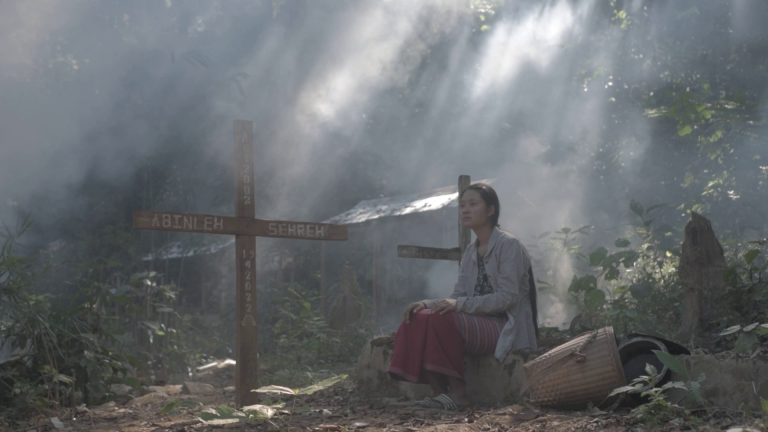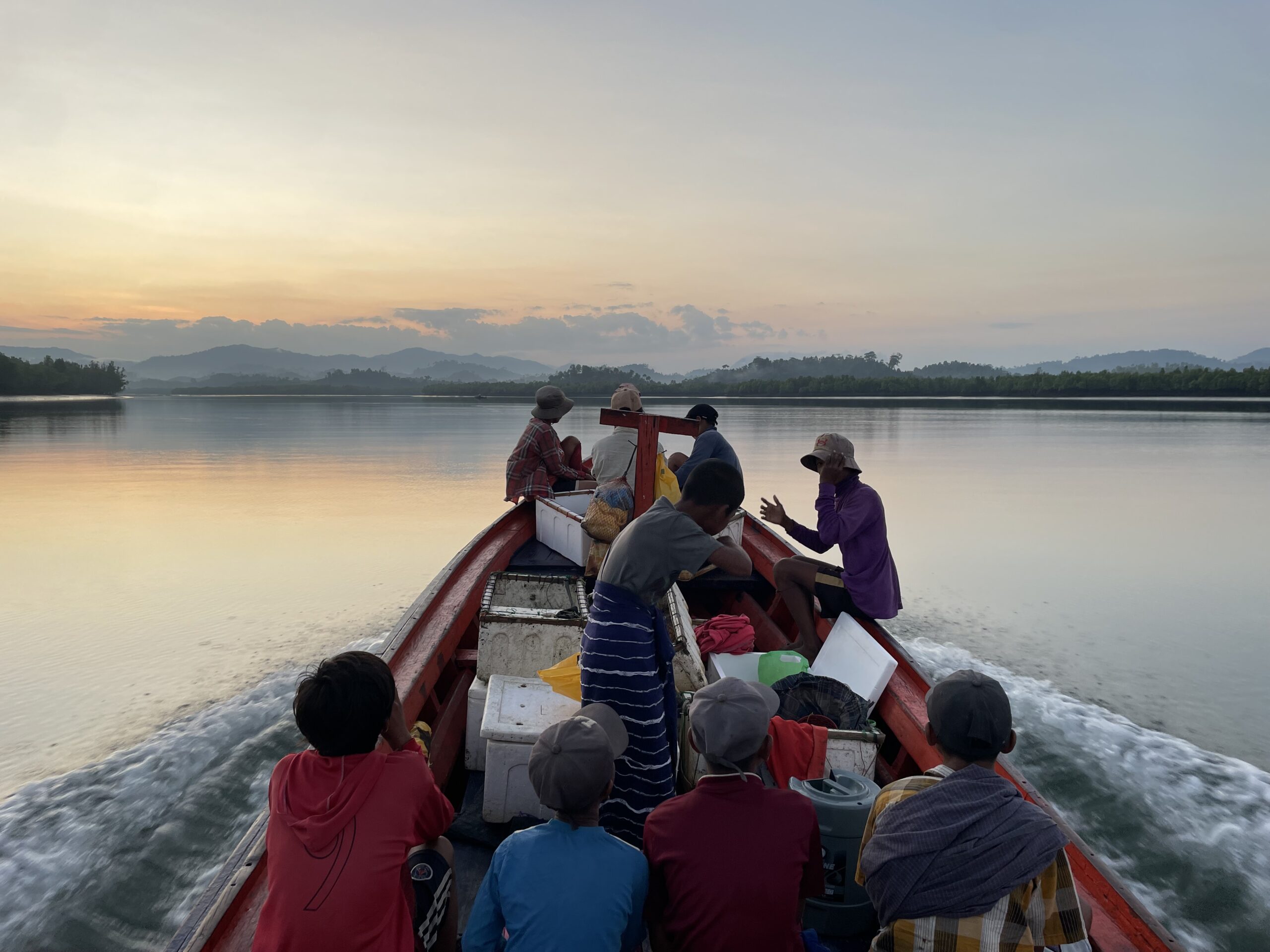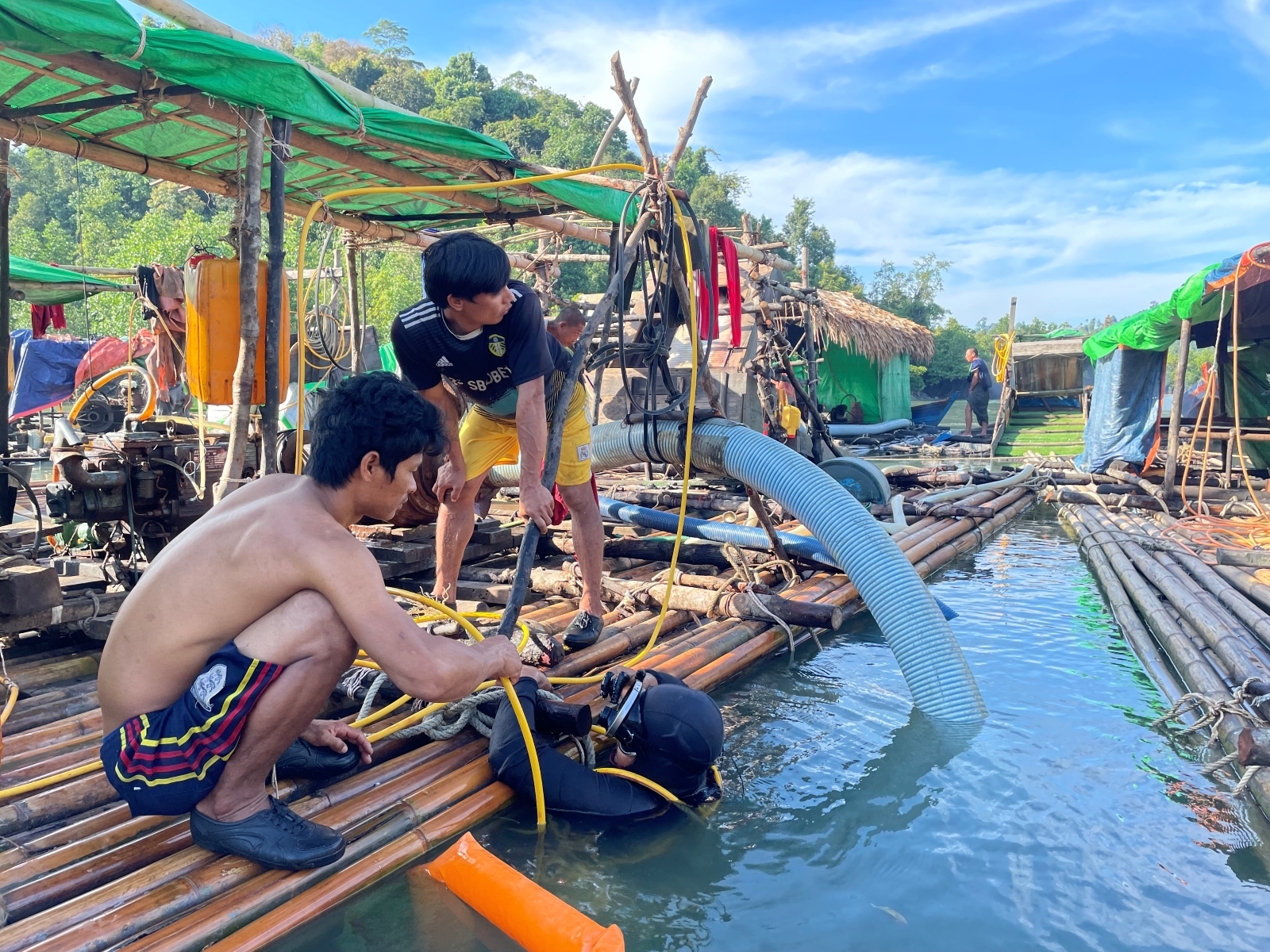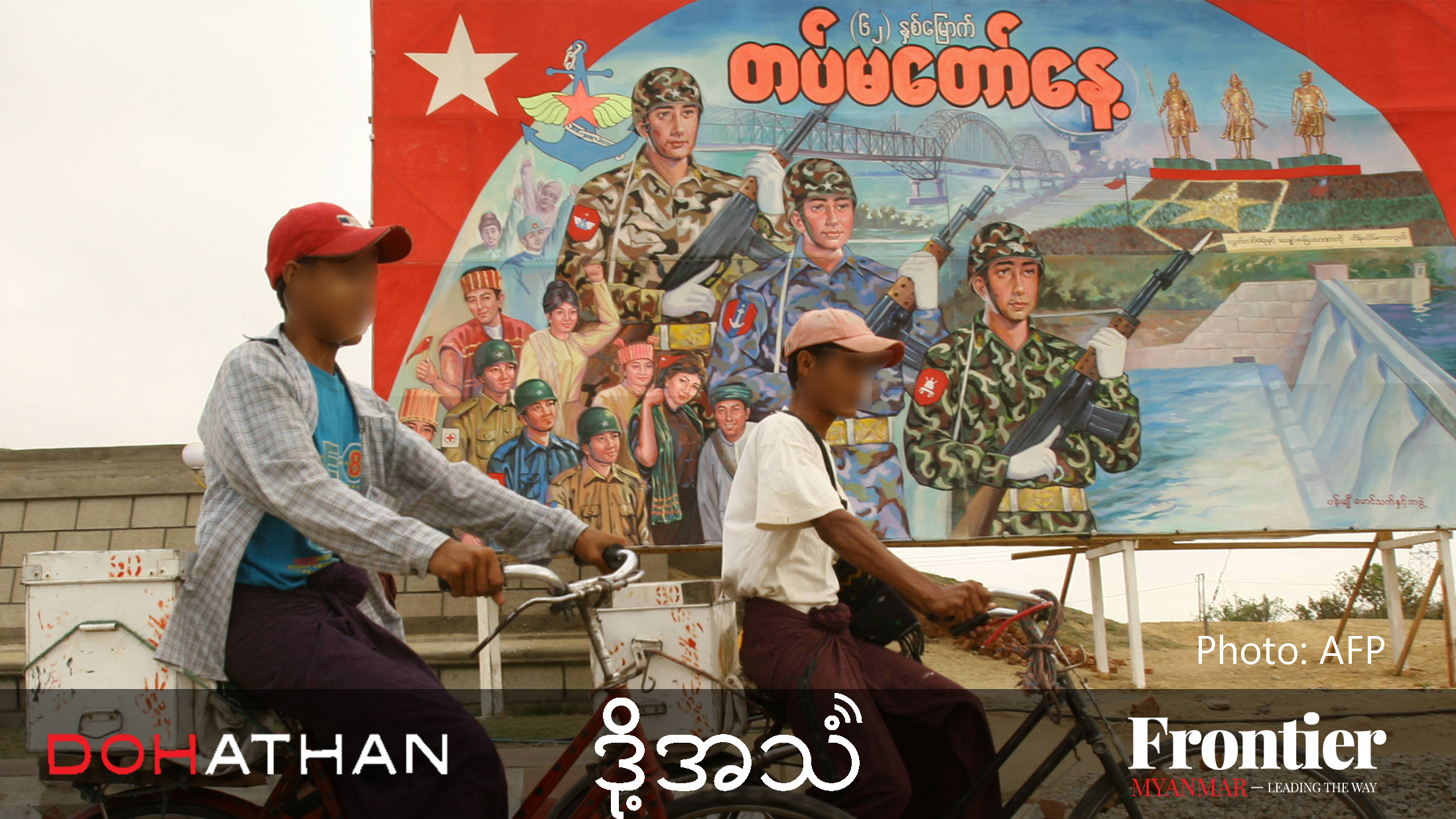The Moken were the nomads of the Andaman Sea until they were forced to settle on land. Now, some Moken risk losing their fishing waters to pearl farms
By HEIN THAR and BEN DUNANT | FRONTIER
KO BABU stands on the sandy shore of Langan Island, watching the slowly moving boats.
His workers, in small dugout canoes rowed by one person, are ferrying supplies that include cooking utensils, fuel and bags of various sizes to a large vessel moored further out to sea. After loading their supplies, and their canoes, on the bigger boat, they wave goodbye to Babu.
Babu has the weather-beaten face and coarse hair of someone who has lived his life by the sea. He was born and raised among the more than 800 islands that form the Myeik (formerly Mergui) Archipelago, off Myanmar’s southern Tanintharyi Region. Babu belongs to a little-understood ethnic group, called Moken in the group’s own language and Salone in Burmese, that is native to these islands.
As the big boat heads towards the horizon, Babu says in thickly accented Burmese that he expects their trip to take about five days. “I gave them a bag of rice that would last about a week for nine men,” he says.
Support more independent journalism like this. Sign up to be a Frontier member.
When the boat arrives at deep waters, the canoes are unloaded and used for catching squid. When they have caught enough, they return to the islands where they live and sell their catch.
In this way, many Moken are able to make a living, but some fear this livelihood is at risk. The waters through which they once roamed freely are being increasingly contested by commercial interests. The Moken of Langan Island are struggling to protect their fishing rights against a company staking out pearl farms. This, however, is only the latest in a long series of threats to their livelihoods and cultural identity.
Some refer to the Moken romantically as “sea gypsies”, and their “nomadic” lifestyle on the Andaman Sea is extolled as a pre-historic relic, deserving of government protection or promotion as a tourist asset. In June last year, the upper house of parliament approved a proposal to establish a protected area for the Moken in part of the archipelago, with access to certain islands tightly regulated.
The Irrawaddy quoted unelected Tatmadaw lawmaker Major Kyaw Soe Oo as telling parliament, “The Salone or Moken are one of the nine sub-tribes of the Bamar, and if our country can help the Salone, it would not only protect them, but also have great benefits for our tourism sector.” The major was referring to the Moken’s place within the government’s official typology of national races, in which they are grouped with the Bamar with seemingly no linguistic or anthropological basis.
However, the “sea gypsy” romance obscures the degradation of the Moken’s traditional way of life – in which the government has played an active part – and a precarious present-day reality, in which their numbers have dwindled to only 1,630, according to a count conducted this year by village tract administrators under the General Administration Department.
For more than a decade, Moken have been permanently settled on island villages, where intermarriage with other groups is common and children attend schools where only Burmese is spoken. Many Moken feel today that their group, and what remains of its unique culture, is on the verge of extinction.

Langan Island (Hein Thar)
Nomads no more
Accounts of the Moken in both academic and popular literature paint a muddled pictured, and the ethno-linguistic group is frequently confused with other so-called sea gypsy communities elsewhere in Southeast Asia that have different ancestries. However, the group’s Austronesian language, and their traditional way of life as maritime hunter-gatherers, distinguishes them sharply from the Bamar, Dawei, Karen and other communities that live on the Tanintharyi coast.
Formerly, the Moken spent their lives sleeping, eating, marrying and raising children on covered boats called kabang that are big enough for an extended family. Each year, they would travel through the waters of the archipelago till the rains arrived in May, when they would build temporary homes on a choice island, re-launching their boats when the skies cleared in October.
Though these houseboats are no longer used, and knowledge of how they’re made is confined to a vanishing number of old Moken men, the smaller dugout canoes, called sabang, remain central to Moken livelihoods. These easily manoeuvrable boats, made out of hollowed tree trunks on the islands where the Moken live, are big enough for one person and are often rowed with bare hands rather than oars.
From these boats, the Moken catch squid with hooked lines. They also dive for oysters and sea cucumbers, which they have traded with communities on the Tanintharyi coast for centuries, but which are today less reliable sources of income than squid fishing.
The Moken’s nomadic existence on the sea began to change substantially in the 1980s, partly because of a rise in piracy off the Tanintharyi Region coast, said U Myint Thein, a Bamar who moved to the area from Yangon more than 40 years ago to find work. He ended up settling on Langan Island of Bokpyin Township and marrying a Moken woman. Myint Thein, whom Frontier met on the island on November 14, said the fear of being robbed or attacked led some Moken to abandon their houseboats and settle on the islands.
Some Moken had earlier settled on an island south of Myeik city known as Owen or Pearl Island, where a businessman named Thakhin Pu established a pearl farm with a Japanese company in 1954. In 1964, two years after General Ne Win seized power in a coup, the business was nationalised under the Myanmar Pearl Enterprise and the Moken were evicted. In 1994, Moken living on Sakaw Island – some of whom had previously been on Pearl Island – were also displaced because of an expansion of pearl farming under the MPE.
“They [the Tatmadaw] burnt down the houses of the Moken, destroyed our boats and drove us away,” recalled Daw Pan, a 70-year-old Moken who had lived on Pearl Island, and now lives on Langan.
In 2000, Major-General Aye Kyway, then chief of Coastal Region Command, wanted to settle all the Moken of the archipelago, who numbered about 2,000, in a single island village. However, the plan failed after the Tatmadaw nullified his position and the Moken remain dispersed throughout the islands of the archipelago.
Most Moken now live on 10 islands, divided between the southern Tanintharyi townships of Bokpyin, Kawthaung and Kyunsu, which span the 170-mile length of the archipelago from Myeik in the north and Kawthaung, on the border with Thailand, in the south.
Not all were forcibly settled on these islands by the government, though some claim they were. One of the most notorious examples is Bocho Island, where in 2004 the military junta held a “Salone Festival” for tourists in a “Sea Gypsy Village” populated by forcibly settled Moken.

A Moken woman on a squid-catching expedition off Langan Island. (Hein Thar | Frontier)
In these island villages, the Moken live alongside other communities, and are in some cases a minority within them. Langan island, which Frontier visited, today hosts a tranquil settlement of about 70 households and less than 400 people drawn mostly from the Moken but also the Bamar and Dawei ethnic groups. Most families make a living from squid catching.
While the Moken children attend primary schools on the islands, most of their parents have little or no formal education and are illiterate. The elders are instead steeped in traditional seafaring knowledge that is not valued in the society they are assimilating into, and so risks being discarded.
While Moken now have citizenship cards, they lack documentation that could prove land ownership. This makes them vulnerable to eviction by the government to make way for commercial projects. “Only three or four houses on this island, including mine, have the required land titles,” said Myint Thein.
On an earlier trip to the archipelago in 2018, Frontier visited Nyaung Wi Island, where 33 Moken households shared the same village with 70 Bamar households. A Moken woman, Daw Sami, said her family’s nomadic way of life had ended 20 years ago, when she was 10 years old. Before then, as a small girl, she would live most of the year in a kabang, and Nyaung Wi was one of several islands where they would shelter during the rainy season.
Only two old men in the village could remember how to make a kabang, Sami said, and none of the Moken youth were interested in learning from them. On their two decades on the island, all the Moken had adopted Buddhism, attending the monastery that had been built next to the village, though traditional animist rites were still performed every April.
Sami said she made a living catching squid with her husband, and her daughter was attending Grade Four at the school in the village. Though Sami still spoke Moken with her daughter, her ambition was to have her daughter graduate from the school and pursue further education on the mainland, where she would assimilate into a non-Moken culture.
Like Sami and her husband, many Moken indirectly supply squid to Thailand’s seafood industry, which exports to world markets.
The squid caught from Moken boats is sold, via middlemen or “brokers”, to vendors at Myeik and at Kawthaung, before most of it is transported in big boats to the busy nearby Thai port of Ranong.
Seafood is big business in Tanintharyi. U Mya Than Tun, a former director at the Department of Fisheries who has been researching marine life off Tanintharyi since 1986, claimed that more than 90 percent of the seafood supplied to buyers in Ranong, the Thai port that sits on the other side of an estuary from Kawthaung, actually originates from the Tanintharyi coast.
Legions of trawlers go up and down the Tanintharyi coast, and if you look out to sea at night, the horizon is dotted with lights from squid boats. The Moken of the archipelago, however, still catch squid by casting tiny hooks from their small canoes.
A skilled Moken can catch up to 60 kilogrammes of squid during a multi-day expedition. A kilogramme of squid fetches about K2,500 (THB50), said Ko Aung Naing, an ethnic Dawei squid broker on Langan Island who buys directly from the Moken. Once exported to Thailand, a kilo sells for about THB200, he said.

A Moken boy on Nyaung Wi Island tars a canoe to make it seaworthy. (Ben Dunant | Frontier)
The pearl curse
Catching squid has been the Moken’s main livelihood for the last decade. Before that, there were pearls, which the Moken would prise from oysters snatched from the ocean floor and sell to visiting traders. They would dive without equipment, showing a legendary ability to hold their breath for long periods under water, which scientists have attributed in other “sea gypsy” communities to an enlarged spleen.
Although these wild South Sea pearls are from an oyster species, Pinctada maxima, found elsewhere in Southeast Asia and in Australia, specimens from the archipelago have a special golden lustre, making them highly prized as gems.
The Moken plied this lucrative trade for hundreds of years but were squeezed out in the latter half of the 20th century by the expansion of pearl farms. These farms produce South Sea pearls through a delicate technical process in which oysters are artificially seeded, and their industrial output dwarfed what the Moken were able to collect by free diving.
Data from the Myanmar Pearl Enterprise shows that there are 12 companies producing farmed (or “cultured”) pearls on 12 different islands. Only one of the ventures is fully state-owned. Of the rest, seven involve Myanmar-based companies and four foreign companies. Myanmar investment rules dictate that these companies must form joint ventures and sign production-sharing contracts with the MPE, which is under the Ministry of Natural Resources and Environmental Conservation. Under these contracts, the state-owned enterprise receives a share, generally 25 percent, of all the pearls produced.
U Myo Lwin, deputy general manager for the MPE in Tanintharyi Region, said Myanmar’s pearls are mostly sold to buyers from Hong Kong, China, Japan and America. The de-listing of the MPE from United States sanctions, along with several other state-owned enterprises, was a big boon for the industry in Myanmar, which is valued at more than US$100 million a year.
The waters of the archipelago provide an ideal environment for farmed pearls, but the oysters that produce them are fussy. Considerable expertise is required to produce a good harvest, and much of the expertise – as well as the capital – has come from Japan, which has led pearl culture globally since Mitsubishi pioneered the South Sea pearl oyster in 1916.
The biggest producer of pearls in Tanintharyi is Myanmar Tasaki Co Ltd, a Japanese joint venture with the MPE that produces about 220,000 pearls a year. The second biggest producer, Orient Pearl, harvests about 120,000 pearls a year. Myo Lwin said most of the producers use techniques innovated by Tasaki in the archipelago.
Private company Tasaki signed an agreement with the military government to farm pearls in the archipelago in 2001. The agreement allotted the MPE 25pc of production but after 2018 this fell to 20pc. Tasaki, which declined to be interviewed by Frontier, currently has two pearl farms around Dome Island in Kyunsu Township and its operational area covers the equivalent of 29,000 acres (about 11,735 hectares), according to Myo Lwin from the MPE.
U Hla Htwe, Tanintharyi Region Minister of Natural Resources, told Frontier on November 13 that Tasakai’s agreement with the government expires in 2020 and the company, which has so far invested more than $8 million in the venture, submitted a five-year extension request in 2018. The request includes a proposal to establish another three farms in an area of 17,000 acres in a group of five islands known as the Sisters Islands, which includes Langan.
This proposal has raised alarm among the Moken, who depend on the waters around these islands for squid and fear they could lose access to them if Tasaki’s request were granted and the new farms established.
Babu said the MPE had previously dealt harshly with Moken who strayed onto pearl farms. “The pearl farmers abused the Moken, accusing them of stealing their company’s pearls,” he said. “They seized the squid that the Moken had caught and some Moken were arrested and detained for three or four days.”
Hla Htwe said the three new sites were actually included among five permitted sites in the original 2001 agreement, though the company had so far only farmed in two of them. Moken on Langan Island told Frontier that Tasaki had erected buildings on one of the islands and buoys had been placed to denote that access was now restricted. They said they were never told the details of the 2001 agreement, including the areas where the company can farm, and had previously thought it was confined to the waters around Dome Island.
The Moken are determined to keep plying their boats around the Sisters Islands. “There are no other islands we can go to,” said U Thein Zan, the Langan village tract administrator, who is married to a Moken but is Bamar. Thein Zan said the regional government had assured them that they could continue living on Langan Island, but the inability to freely catch squid in the surrounding waters would make it hard for them to survive there.
Daw Pan agreed: “If they occupy the area on which we rely for a living, how can we live here?”

A Moken man on Langan Island before a multi-day squid catching trip. (Hein Thar | Frontier)
Moken in Nay Pyi Taw
In 2018, after Tasaki made its extension request, the people of Langan Island, joined by Moken from elsewhere in the archipelago, wrote to the Tanintharyi regional government to demand that Tasaki leave the Sisters Islands untouched.
In September this year, a group of Moken travelled to Nay Pyi Taw, where they met Deputy Minister of Natural Resources and Environmental Conservation U Ye Myint Swe.
On November 3, regional natural resources minister Hla Htwe inspected Langan and the surrounding islands. Ye Myint Swe assured the Moken that Hla Htwe’s report would guide the government’s decision over granting Tasaki an extension. Hla Htwe told Frontier his report would be filed by the end of the year.
Babu said that if the Moken were prohibited from catching squid in the area they would move to Thailand, where other members of the group lead a precarious existence as illegal migrants and are regularly exploited as labourers in the commercial fishing industry.
“Genocide does not only mean killing with guns or swords,” said Langan administrator Thein Zan. “It can also mean stopping people from being able to make a living.”
Recalling how the military evicted her and her family from Pearl Island 55 years ago to make way for an MPE pearl farm, Daw Pan said, “We were abused because of pearls. I can’t even stand to hear the word ‘pearl’ any more.”
“Pearls are a symbol of Tanintharyi; we can’t say they should not be produced,” she said. “But how can we love pearls when they are the cause of the Moken being driven from their homes?”







